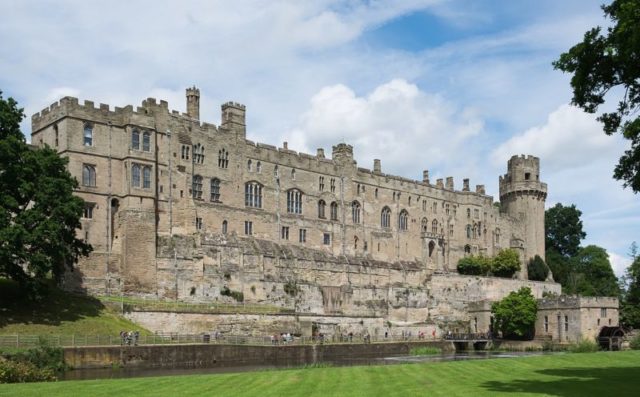Situated in Warwickshire, England, on a bend of the River Avon, Warwick Castle was built in traditional motte-and-bailey style. It’s story begins with William the Conqueror who, according to the BBC, “From the Battle of Hastings to the Domesday Book, William was responsible for truly extraordinary events in England’s history.”
In October 1066, William Duke of Normandy set forth across the English Chanel with his French-Norman army with just one goal — to take the English crown from the Anglo-Saxon King Harold. Harold was famously killed by an arrow that struck him in the eye during the Battle of Hastings, and William became the first Norman King of England. So, was William the Conqueror just a power-hungry warmonger? As with many wars, it came down to politics.

Harold was installed on the English throne following the death of Edward the Confessor, who had ruled since 1042. It was not unusual for allegiances between royal families to be reinforced with marriage, and this of course means a complicated cross-border family tree.
Okay, try to keep up: Edward’s mother was the daughter of Richard I of Normandy, and his father, King Ethelred II “the Unready” had spent much of his reign in exile in Normandy while England was controlled by the Danes. When Edward took the throne, he retained friendships with the Norman nobles, much the chagrin of some of the English lords, and it is possible that he may at one point have promised the crown to William. But Harold Godwinson, Earl of Wessex, helped Edward out with subjugating the rebellious Welsh, so he named Harold as the his successor shortly before he died.
Harold was, according to most accounts, an unpopular choice. Especially with William, who felt the line of succession, whether it had been promised or not, should fall to him. Citing family ties, William — well, he conquered.

Warwick Castle was erected in 1068 on the site of an earlier burh fortification which had been built in the 900s to defend the area from Danish invasion, and was protected by a series of banks and ditches. Expanding on the Anglo-Saxon earthworks, William’s plans included flattening any existing buildings that were in his way. The Domesday Book, finalized in 1086, records the demolition of four houses.

Once the castle was completed, William appointed a Norman lord, Henry de Beaumont, as constable. Beaumont would be granted the title 1st Earl of Warwick many years later. He was succeeded by his son Roger de Beaumont, 2nd Earl of Warwick, who retained controlled of the castle until it was taken over in 1153 by the invading forces of Henry of Anjou (King Henry II of England 1154-1189). Roger de Beaumont’s wife surrendered Warwick Castle to Henry after she was tricked into believing that her husband was dead.

The Gesta Regis Stephani, an account from the period written by an unknown author, records that although Roger was very much alive when the castle was handed over, he died upon hearing the news.
King Henry II later decided to return the fortification to the Earls of Warwick as they were supporters of his mother, Empress Matilda. It was during this era that the wooden keep was replaced with the stone castle that stands today. The Beaumonts remained loyal to the crown during a rebellion against Henry II, and Warwick Castle was passed down through their family line until 1264.

It fell in a surprise attack by Simon de Montfort, the leader of the Second Barons’ War, a civil war against King Henry III. Knowing the Earl of Warwick was a staunch royal supporter, his stronghold was an obvious target for the agitators. According to the 15th century historian John Rous, who wrote a detailed chronicle of the Beauchamp family, a section of the castle wall was deliberately damaged to so “that it should be no strength to the king.”

Warwick Castle and the Earls of Warwick played a starring role in a number of notable events throughout history. The castle even served as a prison for King Edward IV during another series of battles for control of the English crown, the Wars of the Roses, in the 15th century. The last of the first series of Earls of Warwick, Edward Plantagenet, was locked up in the Tower of London when he was just ten years old because he might have had a valid claim to the throne. He was accused of plotting to escape and executed for treason by King Henry VII in 1499.
In the mid-15th century, John Leland, English poet and antiquarian, visited the castle and noted that a large part of it lay in ruins. It remained in disrepair until 1604, when it was gifted to Sir Fulke Greville and subsequently converted into a country house.

The castle was opened to visitors at the end of the 17th century. Many important individuals came to visit, including Queen Victoria in 1885. The same year, the Earl decided to close the castle to the public.
At the start of the 20th century, it was again reopened to the public. Extensive renovations were carried out over the years, and it was awarded the title of ‘best castle in Britain,’ according to the Good Britain Guide 2003. The castle remains open to the public today and it is among the world’s most visited strongholds.

Warwick Castle offers a number of events targeting all audiences, for instance the tourist guide website Shakespeare’s England informs us that “A visit to the castle wouldn’t be complete without watching the jousting tournament (summer only), the magnificent Birds of Prey, or the world’s largest trebuchet launching a fireball – an impressive sight to behold!” The Guardian gives this place a rating of 7.5 and writes, “It’s a proper and full day out.”
